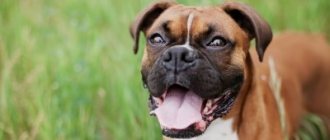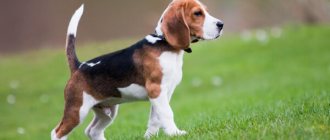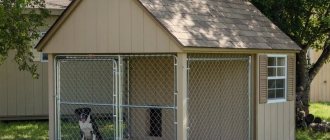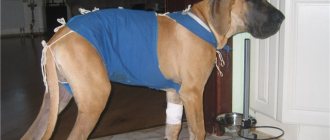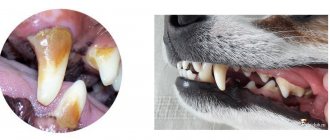Dog owners know that their pets have baby teeth at a young age, which are gradually replaced by permanent teeth. However, not every owner knows how many teeth a dog actually has. Therefore, it is recommended to study the structural features of animal jaws, to know exactly the quantity and methods of maintenance in order to ensure your pet a long and healthy life.
Not every owner knows how many teeth a dog has
Dog's dental system
The structure of a dog’s oral cavity plays a rather serious role. The life and condition of the pet depends on how it is developed. The dental system and bite play a role in the following cases:
- attack,
- protection,
- capture,
- retention,
- grinding and tearing food,
- finishing off prey.
This is why it is very important that the dog’s jaw is in perfect order. Otherwise, the pet’s quality of life is significantly reduced.
Dental problems
The most common oral diseases in dogs are:
- Plaque is the safest disease that can be treated with regular cleaning procedures. You can remove it at home, following all the veterinarian's instructions.
- Tartar forms if plaque is not removed for a long time. This disease is much more serious, as it can lead to the loss of incisors and canines.
- Gingivitis is a disease characterized by an inflammatory process that is a consequence of tartar.
All of the diseases listed above are links in one chain, so it is very important to monitor the health of the oral cavity at the initial stage. To ensure that your pet does not experience difficulties related to dental health, it is necessary from the very beginning to perform ordinary, simple procedures and monitor the dog’s nutrition and health.
Number and location of teeth
The number of teeth may vary slightly depending on the type of dog. On average, the cavity contains 42 pieces. There are 20 pieces in the upper part, 22 on the lower jaw.
The arrangement of a dog’s teeth is conventionally divided as follows (if you mentally divide it in half):
- The upper part - 3 incisors, 1 canine, 4 false roots (premolars), 2 molars (molars) - in the left and right zone.
- The lower part is exactly the same, but there are more molars - 3 each.
You can consider the anatomy of the location in more detail in the diagram below.
The number and types of teeth should be almost the same in all breeds
Dog dental diagram
Dogs are omnivores, but the basis of their diet is meat. The teeth of tetrapods “reflect” their evolutionary development. After all, dogs had to move from a purely carnivorous lifestyle to an omnivorous one, it’s all because of the progress and demands of people.
By type, teeth are divided into:
- Incisors. Small teeth that are found at the front of the jaw. They are used for scraping and are shaped like sharp spatulas. Dogs use their incisors to groom their fur, nails, and skin. During play, dogs' incisors help them hold small objects.
- Fangs . Long and pointed teeth that are located just behind the incisors. These teeth are used for tearing food. They are also used to secure an object (prey) that the dog may hold in its mouth.
- Premolars. Teeth with sharp edges located behind the fangs. They are used to chew and grind any food. Premolars are knives that cut thin layers from a large piece.
- Molars. The outermost teeth behind the premolars. Used to grind even the hardest foods.
Adult dogs have 42 permanent teeth:
- Cutters – 12 pieces.
- Fangs – 4 pcs.
- Premolars – 16 pcs.
- Molars – 10 pcs.
How much should be normal?
The number of teeth may vary depending on the type and age of the dog.
In puppies
At birth, puppies are toothless; the incisors in the center grow when the baby is three weeks old. They are dairy:
- Between 4 and 6 weeks of age, the incisors grow.
- From 3 to 5 weeks, fangs can be seen.
- Premolars gradually grow in 5-6 weeks.
When a baby reaches two months of age, as a rule, he already has 28 teeth (14 on each jaw). During the teething period, the puppy needs help to reduce discomfort. It is best to give your baby specific toys to scratch his gums. This will help avoid damage to things in the house.
Molars in babies can be seen by the age of 4 months, and they are immediately permanent. When changing, a gradual loss of milk occurs - the permanent ones force them out of their place. Initially, the incisors are replaced, then the canines and false roots.
Attention! As a rule, by 7 months the dog has grown all 42 pieces. If the sequence is violated, you must immediately visit a veterinarian.
During replacement, immunity decreases, so at this time it is important to monitor the pet’s condition - provide a nutritious diet, and ensure that hypothermia does not occur. After complete replacement, repeated vaccinations are carried out.
In adult dogs
How many teeth does an adult dog have? All temporary ones are completely replaced by permanent ones by 7 months. From now on, she has 42 of them - 20 on the upper jaw and 22 on the lower jaw.
The life and development of your pet depends on the health of the oral cavity, so it is recommended to monitor its condition and take the necessary measures to eliminate problems in a timely manner.
Up to a certain age, puppies have milk teeth, which are then replaced by permanent ones.
First teeth
During puppyhood, a dog does not yet need a full set of teeth. At the very beginning they feed only on milk, later on porridge and other food that does not require much chewing. They don’t have to defend themselves, because their mother will always stand up for them. Therefore, the first teeth begin to appear in babies mainly at the age of 3-4 weeks, although in representatives of decorative breeds this occurs much later - at 6-7 weeks of age.
The very first fangs erupt. They are necessary for tearing food apart, and for predators in the wild this is the first necessity. The next to appear on the gums are the incisors, the last are the premolars (in other words, “false molars”). The dental formula for puppies looks like this:
- Upper jaw: 2 canines and six incisors and premolars.
- Lower jaw: full coincidence with the upper jaw.
As they grow older, baby teeth are replaced by permanent teeth (with roots).
Special formula
A dog's dental formula is a special diagram that describes the location of teeth in the oral cavity of a furry dog. Letter and number combinations are used for this purpose.
As a rule, numbers indicate the number of teeth of a certain type, and letters indicate their variety. Below you can see common notations.
- I - incisors (Incisivi),
- C - fangs (Caninus),
- P - premolars (Praemolares),
- M - molars (Molares).
Therefore, the dental formula for the structure of a dog’s jaw looks like this:
- 2M 4P 1C 3I 3I 1C 4P 2M - upper jaw,
- 3M 4P 1C 3I 3I 1C 4P 3M - lower jaw.
Deviation from this formula is often considered a vice.
Features of the dental system in dogs
The dental formula of these animals includes three groups: incisors, canines and molars. The latter type is divided into two more subgroups: molars and premolars. They have different surfaces:
- chewing - most developed on the molars, involved in the primary mechanical processing of food;
- labial, lingual and buccal - interacts with the corresponding structures of the oral cavity;
- contact - this surface is where the teeth come into contact with each other.
Note! The correct bite of an animal is formed if:
- the upper and lower jaws do not touch each other (the distance between them is no more than 3 mm);
- The upper canines protrude and cover the lower ones.
Types of teeth
Dogs grow several types of teeth. Each variety has characteristic features, description and purpose for the animal.
Incisors
There are 6 incisors on both jaws. However, some dogs may have both 7 and 8. This depends on the space between the canines. On the left and right sides of the line that can be used to divide the jaw into two equal parts, there are hooks. Then there are the middle ones, and after them the edges.
Attention! The incisors have a single root.
In adulthood, the number of teeth reaches 42.
Fangs
Fangs are long teeth that are cone-shaped and slightly curved outward. They are located between the incisors and premolars. They differ in one and quite powerful root. A dog of this type has 4 pieces - 2 on each jaw.
Molars, premolars in dogs
Premolars are located immediately behind the canines. Together with molars, they belong to the indigenous species. There should be 4 premolars; they are present on both jaws. After this are the molars.
In animals they immediately grow permanent and are located on both sides. There are 2 of them on the upper jaw, 3 on the lower jaw. They are necessary so that the dog can chew food thoroughly.
Baby teeth
So, let's start, of course, with baby teeth. Like most mammals, dogs are born completely toothless. Milk teeth begin to erupt in puppies at 3-4 weeks, and only appear completely at 5-8 weeks.
This is typical for most quadrupeds. But among representatives of small decorative breeds, the first teeth begin to cut only at the age of 6-7 weeks. At this time, babies may feel unwell, spoil things (to scratch their gums), and begin to bite.
The puppy should have a total of 28 baby teeth, 14 on each jaw. The dog's canines begin to erupt first, followed by the incisors, and the last to erupt are the premolars:
- Upper jaw: 2 canines, 6 incisors, 6 premolars.
- Lower jaw: 2 canines, 6 incisors, 6 premolars.
If the number of teeth is more or less, or there is a malocclusion, then you should consult a veterinarian about this problem.
Number by breed
Depending on the dog's breed, the number of teeth may also vary. For example, large animals - German Shepherds, Rottweilers, Staffords, Labradors - should have strictly 42 pieces. If there is any deviation, the dog is considered defective.
In dogs of medium and small breeds, the number of teeth can vary from 36 to 40 pieces. However, you can often find purebred spaniels or dachshunds in which the number reaches 42.
This volume cannot be found in small dogs due to changes that occurred during the breeding process. Toy terriers, chihuahuas, papillons, pugs are the happy owners of 36-38 pieces.
If the number of teeth is not normal
Unfortunately, the number of teeth in a dog may not always correspond to the norm. As a rule, there are several different reasons that can lead to this:
- During the change of baby teeth, it is recommended to carefully monitor this process. If they do not have time to fall out, then the permanent ones will grow above them. As a result, bite problems may develop. A similar problem often occurs in terriers - you can find dogs with double rows of teeth. This is caused by the carelessness of the owner. If the milk does not fall out on its own, then it needs to be removed.
- If the teeth are smaller than normal, then other reasons are possible. They can fall out due to improper nutrition - the dog does not have enough nutrients. Loss is caused by poor quality jaw care and lack of necessary load on the masticatory apparatus.
Attention! A dog can also lose teeth due to various diseases of the oral cavity or internal organs that arise as a result of heredity.
It is also worth remembering that the number of teeth a dog has changes with age, as does the canine skeleton. Gradually they begin to fall out.
The incisors are changed first
When does a dog's teeth change?
The change of teeth in puppies begins at the age of 3 months and usually ends by 6-7 months. If a complete replacement of teeth has not occurred at 7 months, the bite is incorrectly formed, or you notice other pathologies, then you need to contact a veterinarian for help.
Therefore, try not to give a young puppy with teeth that have not yet been replaced too hard food, which can damage the gums and ruin the bite. Giving bones is prohibited.
If the baby tooth is loose, but cannot fall out, then you can give it a rubber toy or a special “bone” made of connective tissue to chew on (there are plenty of these in pet supply stores). Puppies can start biting and damaging furniture and shoes.
The incisors fall out first, followed by the premolars. What should you pay attention to when changing your dog's teeth? So that when permanent fangs appear, the dog does not have a single milk tooth left. If you notice that a permanent tooth has emerged from the gums, but the baby tooth has not yet fallen out, be sure to remove it (if you can’t do it yourself, contact a veterinarian who will surgically help). If you leave this situation to chance, then there is a high risk that the dog will have an incorrect bite in the future.
You can evaluate it by carefully examining the dog's jaw in a closed position. The following signs indicate the formation of a normal bite:
- the teeth of the upper and lower rows do not touch (allowable gap 1-3 mm);
- the upper canines, when positioned correctly, protrude slightly forward, covering the lower ones;
- each of the lower canines is placed in the free space between the corresponding upper canine and the uppermost incisor.
Thus, most dogs have a scissor bite. The exception applies to boxers, bulldogs, pugs and Pekingese with a pike bite, which is associated with a genetically determined shortened lower jaw.
When is veterinary intervention required?
Dogs also have problems that may require dental assistance from a veterinarian. The most common diseases that you cannot cope with on your own:
- stomatitis - inflammation of the oral mucosa;
- pulpitis - the presence of purulent contents in the root canal;
- caries - damage to tooth enamel;
- periodontitis - damage to the tissue around the tooth;
- tartar - the appearance of hard deposits on the incisors and fangs.
Sometimes teeth can break. This happens as a result of injuries, bites from hard objects, strong pressure, or a lack of minerals in the diet.
Another problem is malocclusion. This condition occurs due to impaired tooth growth. Only a veterinarian can cope with such a problem; you cannot correct the bite yourself.
Fangs also gradually wear out, like other teeth
Gingivitis is an inflammatory process on the gums. The process causes animals a lot of unpleasant moments and suffering - the dog constantly whines and cannot eat normally. The causes of this problem may be changing teeth, the presence of tartar, allergic reactions, or lack of vitamins. Only a veterinary clinic can help your pet.
Attention! Constant dental care is important. It is necessary to accustom your pet to hygiene procedures from a young age. For cleaning you need to choose special toothpastes and brushes.
In addition, problems can be avoided if you periodically give your dog solid food - apples, carrots, bones, special cookies.
Dog dental care
Knowing how many teeth on top and bottom the dog has in its mouth, the owner will be able to receive more information about his pet and properly care for him. Teeth, like a dog's coat, need regular cleaning.
In breeds with a regular bite, teeth cleaning occurs naturally while eating solid food.
Dog breeds with malocclusion require special care for their mouths after eating. In addition to special means of protection and care, you need to monitor your pet’s diet and what he likes to play with.
Balanced food is a source of nutrients for the animal. It does not allow pathogenic microflora to develop in the mouth by maintaining the animal’s immune system in good condition. You should also prevent your dog from chewing on stones or very hard objects that he uses to play on.
